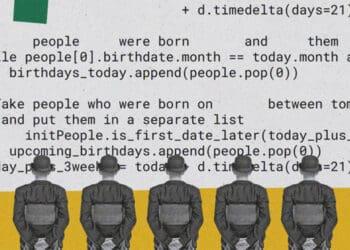The COVID-19 crisis has necessitated technological advancements across the board as many industries have gone remote. FairWarning CEO Ed Holmes discusses what the health care industry should do as this transformation is underway to build patient trust and ensure compliance.
All health care organizations are on a journey toward digital transformation to create a more seamless patient experience, provide stronger clinical insights and deliver improved care outcomes. As an added benefit, a digitally advanced health care organization has more security controls in place to better protect patient privacy and remain compliant. The digital transformation journey has been a slow-moving one for the health care industry, but nonetheless, it’s an important one to reap the benefits mentioned above.
And while the industry is still working through the steps of its transformation journey, it excels in privacy and compliance measures, with 39 percent of health care organizations having advanced privacy programs, compared to 27 percent of other industries. The catalyst for this is the fact that the industry is targeted by more security threats compared to other sectors, causing health care organizations to accelerate their privacy and compliance measures. A fully digital health care environment is the ultimate goal, but along this journey, the right measures need to be applied to protect patient information every step of the way. This includes understanding the flow of patient information, ensuring staff is educated on compliance and privacy policies and utilizing technology to proactively flag privacy incidents.
Digital Transformation Matters – To Patients and Systems Alike
Health care organizations have already started to see the impact of digital transformation on how patient care is delivered when coupled with interoperability. A basic example is when clinicians input patient information using electronic health records (EHRs), rather than through paperwork that needs to be manually uploaded into systems. By using EHRs that any hospital or doctor’s office can access, there are no missing pieces to the patient’s history puzzle if the information is connected. So, you can imagine how when the entire U.S. health care system is digital and interoperable, it can improve overall care and patient outcomes.
Coincidentally, 2020 has been an exemplary year for digital health care advancements. Telehealth, for instance, has seen incredible adoption in a major push toward digital care delivery. The number of primary care visits via telehealth increased 350-fold from pre-COVID-19 levels, so those that already invested in telehealth infrastructure in the last three to six years were able to better scale virtual care services during the pandemic. In the future, telehealth will play a huge role in care delivery amongst other continuing digital transformation, so health care organizations should work to continuously improve these digital workflows. Such improvements should also include layers of privacy and compliance with government regulations, which will continue to evolve to better serve patients – and protect their health data.
Protecting Privacy & Compliance with Every Step
Privacy and compliance are essential to ensuring patient information doesn’t fall into the wrong hands, which can be compromised if it’s not built into the design of digital transformation initiatives. Without privacy by design, the consequences are broken patient trust, poor patient outcomes, heavy fines and reputational damage. Clinicians want patients to feel they can share anything with their doctor or nurse without repercussions, so if patients don’t have 100 percent trust in the security of their health information, the quality of care and outcomes are worse. While today, a majority of individuals (84 percent) are confident their medical records are safe from unauthorized viewing, many have concerns (66 percent) when health information is electronically exchanged.
Imagine if a patient is admitted to a hospital with multiple signs of a health issue but doesn’t disclose certain symptoms because they’re afraid that if anyone outside of their doctors sees this information, it could have negative consequences – from embarrassment to workplace repercussions. Patient trust is just one reason among many as to why compliance is a critical component of the digital transformation process.
Health care organizations can fill any gaps in compliance by reviewing everything that has been transformed to ensure that it’s still fulfilling all regulations and privacy and security policies. Health care facilities also still need to be checking and measuring that staff are adhering to policies, even with the latest technologies in place.
Building a Culture around Compliance and Privacy
In addition to implementing privacy controls, it’s never too late to build a culture of privacy. While open access to patient records is helpful as clinicians move around a hospital or different doctors are called in to help a single patient, it also means that every staff member needs to be educated on hospital policy surrounding records access. Staff should only access patient information that is needed for treatment, payment or operational reasons, as dictated by the HIPAA privacy rule.
Hospital policies are usually already clear on paper to ensure compliance with regulations such as HIPAA and entities including CMS. The problem is when these policies aren’t articulated well to staff or there isn’t clarity on who is accessing what patient information. When this happens, building a culture of privacy and compliance, which includes ongoing education, becomes a crucial step; it encourages staff to do the right thing, even when they’re not being watched.
A culture of privacy and compliance also reduces the risk of a data breach when coupled with the right technology. User monitoring technology can make it easy to understand the flow of patient data and who is accessing which records. Technology that uses a combination of experience-based best practices and artificial intelligence (AI) makes it optimal, which is also key to the digital transformation process, as regulation evolves around patient privacy.
More importantly for compliance, user monitoring technology can help spot when there’s unauthorized access to a patient record, which is an ongoing problem in the health care industry. Not only can the technology flag anomalous behaviors, but, depending on the partner, it can also support the investigation process, which is necessary to preserve patient privacy and compliance. When paired with staff training and education, a balance of the right technology and the right people can provide a secure environment for patient care delivery.
Digital transformation projects are incredibly important to the health care industry to change the privacy game while delivering better care and improving interoperability. It also ensures compliance remains a priority for health care systems. Between a culture of privacy and compliance and technology that can flag unauthorized access to patient records, hospitals can be ready to go above and beyond compliance standards while moving the digital transformation process forward.



 Ed Holmes, CEO of
Ed Holmes, CEO of 









